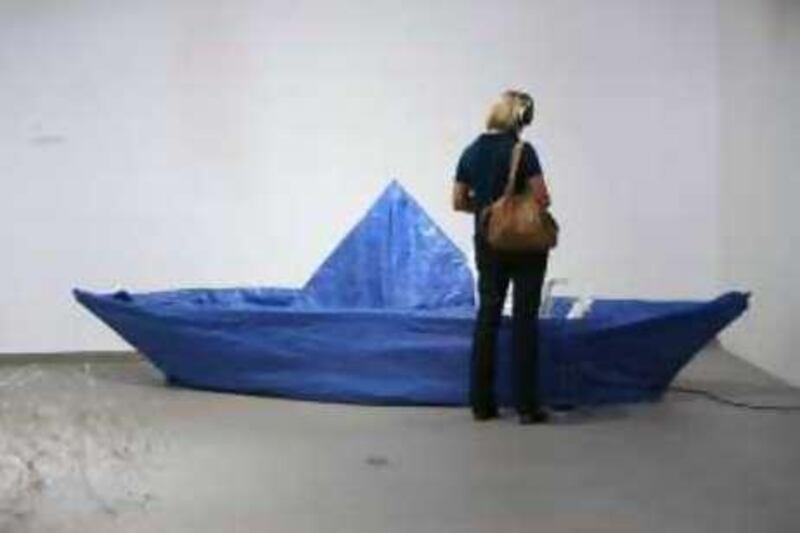Winston Churchill said that criticism might not be agreeable, but it is necessary. The artists currently showing at The Jam Jar Gallery seem to agree, using irony and even silliness to judge their adopted hometown of Dubai. The works evoke the absurdity of everyday life in a visual jibe which poses questions about Dubai's headlong race into the future. The show is called In Situ, a title that plays on the fact that many of the UAE-based expatriate artists who contributed work are - like their installations at The Jam Jar - also in situ for the moment in Dubai. Most, though not all, of the contributors were born and raised in the West and have lived all over the globe. The sculptures addressed a number of issues such as architecture, development and sustainability.
Out of the Dubai-based artists that the The Jam Jar invited to show, many were visual arts professors at UAE universities who showed work created specifically for the show. Walking around the space, one gets the feeling that these artists, having immersed themselves in teaching, have been simmering with ideas and eagerly awaiting the chance to show their work. There were also some student pieces in the show that were not fully developed and simply not on par with the professional work - think a large package of hardware store wire dumped on the floor lacking both purpose and a sense of Duchampian irony.
But within the confines of The Jam Jar's white walls, the mature artists let rip their opinions about what they felt were Dubai's prevailing "isms": egotism, consumerism and commercialism. One of the standouts was the tongue-in-cheek World's Largest Blue Tarp Origami Boat by the husband and wife team Elizabeth Monoian and Robert Ferry. The two deftly use humour to make a visual and conceptual point. World's Largest Blue Tarp Origami Boat as advertised: a large (122cm by 457cm) cobalt blue sailboat made out of a folded oilcloth tarp. Inside the bow are two large sacks of granulated white sugar, chosen for their large-font "Indian Origin" labels, along with a rope coiled willy-nilly. There is something innately futile, even darkly funny, about an oversized tarpaulin boat, since the grandiose size would actually make it sink were it to be set in a body of water.
Monoian, a studio-art teacher at the American University of Dubai, and Ferry, an architect, say that they were inspired to create the piece by the (smaller) origami vessels they had found at building sites in and around Dubai. They were surprised to find so many of these tiny artistic renderings and decided to make these strange, moving vessels the centrepiece of their installation in The Jam Jar. "We have found 30 origami boats and planes specifically at construction sites," says Monoian. "The boats represent the journey home and are being folded by people working here who miss their families." Let's just hope nobody thinks of taking a literal journey anywhere in the Monoian-Ferry watercraft.
Though those elements worked well together, the multimedia dimension of the sculpture was overkill. An LCD screen plunked next to the rope pile shows images of workers welding at a construction site with an overlay of images and sound bites from the movie Fountainhead, the 1949 King Vidor film about an architect who struggles to maintain his ideals. This video and the accompanying soundtrack are interesting enough to stand alone as a separate pieces, but take away from the overall effect of the boat installation.
Another highlight was Burjasaurus by Michael Bray, a funny and terrifying combination of oil drill, dinosaur fossil and model skyscraper. In the artist's statement for the piece, he cannily comments that, "it will be the largest dinosaur tower in the city, possibly the world!" Bray says that the piece was inspired one of his first memories of Dubai when he arrived in the city four years ago. While driving down Sheikh Zayed Road, he thought that the huge buildings resembled brontosauruses walking into the desert, the Mesozoic era recreated in concrete monoliths. In Burjasaurus, a 182cm by 405cm by 300cm sculpture, Bray simultaneously references the dinosaur-buildings he imagined as well as the fossil fuels upon which these skyscrapers were built. The wooden faux-fossil creature has a pelvis, legs, a backbone and arms (complete with claws) but has a red hook hanging in place of a head and a straight beam as its neck. There is an element of the absurd in it - those tiny little dinosaur arms will always be the joke of the species - yet the wooden Godzilla remains poised to lurch on. It is a great reminder that even the greatest of creatures, be they beast or building, can be wiped out, passed over and made obsolete.
The artist Colleen Quigley also has fun with the city's architecture. Her work, Souvenir 1, is a 205cm by 33cm by 122cm tower of translucent Lego, which takes inspiration from the same buildings as Burjasaurus, though the two look nothing alike. Quigley has randomly, in her words, placed candy colours of see-through plastic Lego in a tower, making a shapely building out of the iconic children's building blocks. From the side, the sculpture looks like the Burj Dubai. But when seen from the front, Souvenir 1 has shapely holes made to look Islamic style windows. Quigley says the shape references the strength of modernity and tradition that are both evident in Dubai. "It's not finished; it's open to interpretation," says Quigley, who mentioned that she thinks her work reflects on those constructions that appear randomly almost overnight, toylike and fanciful compared to the environment in which they are placed.
Though In Situ points to many of the city's faults, it does so with humour and an almost childlike delight. These lighthearted jokes about the urban landscape represent something quite rare in a scene - artists taking the opportunity to comment on the environment which surrounds them rather than hiding in abstract, formalistic and, ultimately, saleable, work.
swolff@thenational.ae





